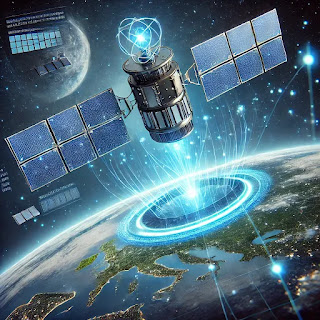India is set to revolutionize secure communications by launching its first quantum satellite within the next 2-3 years. This ambitious initiative will place India at the forefront of quantum technology, enhancing cybersecurity, data protection, and encrypted communication. With advancements in Quantum Key Distribution (QKD) and the National Quantum Mission (NQM), India is making significant strides in next-generation secure networks.

In this article, we explore quantum satellites, how they work, their benefits, and their impact on global communication security.
What is a Quantum Satellite?
A quantum satellite is a next-generation communication satellite that leverages quantum physics principles to ensure unbreakable encryption and secure data transmission. Unlike conventional communication systems, quantum satellites use quantum mechanics-based encryption, making them immune to cyberattacks and eavesdropping.
How Does a Quantum Satellite Work?
Quantum Key Distribution (QKD):
The satellite transmits encrypted quantum keys to ground stations.
These keys use quantum states of photons to encode data securely.
Quantum Entanglement:
Entangled photons are transmitted from the satellite.
Any interference instantly changes the state of the entangled particles, alerting the sender.
Tamper-Proof Communication:
If an eavesdropper tries to intercept the quantum keys, the quantum state collapses.
This makes it impossible to steal data without detection.
By integrating QKD and quantum entanglement, quantum satellites provide unprecedented security for global communications.
Quantum Key Distribution (QKD): The Core Technology
What is QKD?
Quantum Key Distribution (QKD) is a technology that allows two parties to securely exchange encryption keys using quantum particles like photons. It is the foundation of quantum-secure communication.
How Does QKD Work?
Photon Transmission: Secure quantum keys are sent using individual light particles (photons).
Quantum Entanglement: If a hacker attempts to intercept the key, the quantum state of photons changes immediately, rendering the data unreadable.
Key Validation: The system detects unauthorized access, ensuring secure key exchange.
Why is QKD Unbreakable?
Traditional encryption can be hacked by supercomputers.
QKD follows the laws of quantum mechanics, which prevent data interception without alerting the users.
Even future quantum computers will be unable to break QKD encryption.
National Quantum Mission (NQM): India’s Quantum Leap
What is the National Quantum Mission (NQM)?
The National Quantum Mission (NQM) is a flagship initiative by the Government of India, designed to boost research, innovation, and industrial applications in quantum technology.
Key Features of NQM:
Launched by PM-STIAC (Prime Minister’s Science, Technology & Innovation Advisory Council).
₹6003.65 Crore budget allocated for 2023-2031.
Focuses on scientific research and industrial R&D.
Aims to develop a strong quantum ecosystem in India.
Four Thematic Hubs (T-Hubs) Under NQM:
Quantum Computing: Development of advanced quantum processors, algorithms, and computing systems.
Quantum Communication: Enhancing secure data transmission and cryptography.
Quantum Sensing & Metrology: Creating high-precision sensors for defense, healthcare, and space applications.
Quantum Materials & Devices: Developing quantum materials and semiconductors for next-gen technology.
NQM will position India as a global leader in quantum technology, ensuring strategic dominance in secure communications, computing, and sensing applications.
Benefits of Quantum Satellites
1. Unhackable Communication
Traditional encryption is vulnerable to hacking.
Quantum satellites provide tamper-proof, secure communication.
Military, government, and financial institutions will benefit from ultra-secure networks.
2. Advanced Cybersecurity
Cyber threats and espionage are increasing globally.
QKD-based satellites will protect sensitive data from cyberattacks.
Ensures secure financial transactions, defense communications, and diplomatic messages.
3. Next-Gen Space Technology
India will join global leaders like China and the USA in quantum satellite research.
Strengthens India’s role in space-based quantum communication.
4. Scientific and Industrial Innovation
Encourages collaboration between academia, startups, and industries.
Boosts R&D in quantum materials, sensors, and AI applications.
5. Secure Internet and Cloud Computing
Enables quantum-secure cloud storage and internet communication.
Protects user data from future cyber threats.
Challenges in Quantum Satellite Implementation
1. High Development Costs
Quantum technology requires expensive R&D.
Large investments are needed for infrastructure and skilled workforce.
2. Complex Engineering
Requires advanced satellites, precision instruments, and entangled photon generators.
The transmission of quantum signals over long distances is still a challenge.
3. Global Competition
China has already launched quantum satellites like Micius.
India must accelerate research and development to remain competitive.
4. Adoption by Industries and Government
Organizations must upgrade existing networks to integrate quantum-safe communication.
Training programs are needed for professionals in quantum technology.
Despite these challenges, India’s quantum satellite initiative marks a revolutionary step towards secure communication.
FAQs on Quantum Satellites
1. What makes quantum satellites secure?
Quantum satellites use Quantum Key Distribution (QKD), which ensures that any attempt to intercept data alters the quantum state of photons, making hacking impossible.
2. How will quantum satellites benefit India?
They will enhance national security, cybersecurity, secure government communications, and financial data protection.
3. Which countries have quantum satellites?
China launched the world’s first quantum satellite, Micius, in 2016. The USA and Europe are also investing in similar technologies.
4. What is quantum entanglement?
It is a phenomenon where two particles remain connected, so changing one particle instantly affects the other, regardless of distance. This principle is used in quantum communication.
5. When will India launch its first quantum satellite?
India plans to launch its first quantum satellite within 2-3 years, advancing secure communication and national security.
Conclusion: India’s Quantum Future
India’s planned quantum satellite launch will establish the nation as a global leader in secure communication. With the National Quantum Mission, India is paving the way for quantum computing, cybersecurity, and next-gen space technology.
As the world moves toward quantum-secure internet and global networks, India’s advancements in quantum satellites will redefine secure communication, digital privacy, and cyber defense.
The future of communication is quantum, and India is ready to lead the way!











